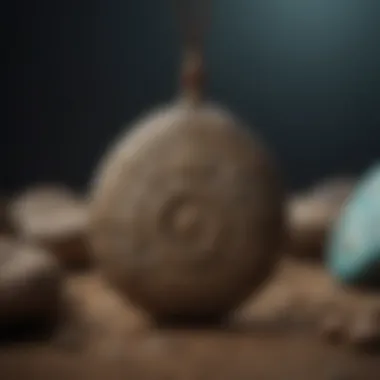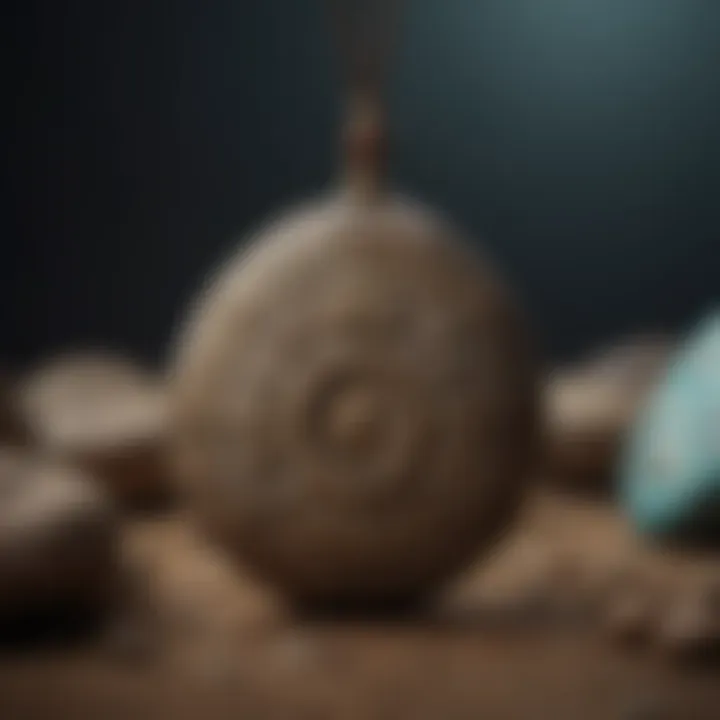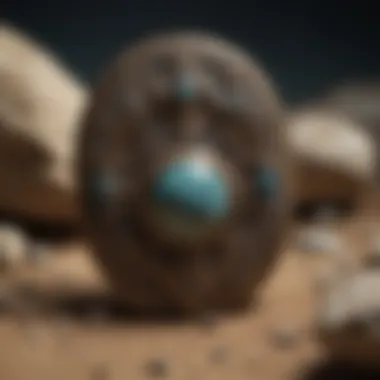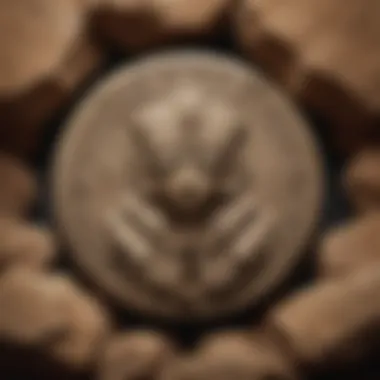Exploring Ancient Egyptian Amulets for Protection


Intro
The ancient Egyptian world is one steeped in mystique and rich narratives, especially when it comes to the artifacts they left behind. Among these, amulets stand out as powerful symbols, woven into the very fabric of their culture. These small tokens, often crafted with precision and infused with meaning, played a vital role in Egyptian society. The study of amulets not only shines a light on the beliefs and practices of an ancient people, but it also touches on universal themes of protection and empowerment.
As we peel back the layers of history, we'll uncover the origins of these fascinating objects, their classifications, and the various meanings associated with them. Delving into the intricacies of their design and the materials used will also provide insight into their revered status in both life and death. From palms open in prayer to intricate carvings of gods, every detail echoes the Egyptians’ desire for safety, strength, and an eternity that echoed beyond the grave.
This journey we’re taking will not just be an academic exercise; it serves as a doorway into understanding how symbols, even small ones like these amulets, can wield tremendous power through generations.
Preface to Ancient Egyptian Amulets
The importance of ancient Egyptian amulets can scarcely be overstated. In a culture that held deep beliefs in the supernatural, these small yet significant artifacts served as more than mere decorations. They were seen as powerful symbols of protection and divine favor, each one intricately linked to the daily lives, afterlives, and spiritual practices of the ancient Egyptians. This article aims to unravel the layers of meaning behind these objects and to shed light on their multifaceted purposes.
Definition and Purpose
Amulets were objects that were imbued with magic and belief, intended to bring good fortune and ward off evil. Definitions typically emphasize their role as protective symbols. They could take numerous forms, ranging from intricate jewelry to simple stones, each resonating with specific spiritual meanings. For instance, wearing a scarab amulet was believed to ensure safe passage through the trials of life and death.
The purpose of these amulets extended beyond personal protection. They were also used in burial practices, providing safety and favor to the deceased in the afterlife. By placing amulets in tombs, the living hoped to bolster the deceased’s chances against the perils that awaited them in the realm beyond.
Historical Context
To understand the full significance of amulets, one must grasp their historical roots. The use of amulets dates back to the Pre-Dynastic period, evolving over thousands of years to reflect the shifting societal norms and religious beliefs. In a world shrouded in mystery, the ancient Egyptians relied on these objects to navigate the spiritual landscape.
The context is critical; as society progressed through different kingdoms, the design and meaning of these amulets adapted to the changing beliefs. In early periods, amulets often featured simple designs, while later iterations became more elaborate and stylized, indicating both advancements in craftsmanship and the deepening complexity of religious thought. The evidence of amulets found in various archaeological digs illuminates the evolution of techniques, diversity of materials, and the ever-expanding catalog of symbols that were significant to the ancient Egyptians.
"Ancient Egyptians believed that objects could hold intrinsic power, and hence, their amulets became a part of the dialogue between the physical and the supernatural realms."
In summary, the introduction to ancient Egyptian amulets serves as a gateway to comprehending their complex roles within a society that revered both life and afterlife. Each amulet tells a story of protection, power, and identity, threading together the fabric of a culture that was as rich in tradition as it was in mystical beliefs.
The Evolution of Amulets in Ancient Egypt
The exploration of amulets in ancient Egypt is not merely about the objects themselves; it encapsulates a journey through time, revealing how these artifacts transformed in form and meaning. The evolution of amulets signifies the shifts in cultural beliefs, technological advancements, and social practices. Each era's amulets tell us a story that showcases the relationship between the people and their deities, the afterlife, and the universe itself. Examining how amulets have changed over the centuries sheds light on the broader aspects of ancient Egyptian life.
Amulets in Pre-Dynastic Egypt
The roots of amulets can be traced back to the Pre-Dynastic period, where they served a practical and magical purpose. Crafted from available materials like stone, bone, or clay, these early amulets were simple, often featuring natural forms like animals or plants. They were believed to provide protection from harm, assist in hunting, and ensure fertility.
In this period, amulets often reflected the daily experiences and struggles of the people. For instance, a small representation of a fertility symbol was common for women wishing to conceive. Additionally, the understanding of amulets as protective entities originated here, laying the groundwork for future developments in amulet significance.
Amulets through the Middle Kingdom
With the emergence of the Middle Kingdom, amulets experienced a renaissance. This era saw significant advancements in craftsmanship and a deeper grasp of spiritual significance. Amulets became more intricate, with symbols and inscriptions often reflecting the names of gods or protective entities.
Items like the scarab beetle became emblematic in this period. The scarab amulet, viewed as a symbol of rebirth and resurrection, illustrated the Egyptians' beliefs in the afterlife. It was common for these amulets to be placed in tombs, positioning them as vital artifacts in not just life but in the greater journey beyond it.
"In ancient Egypt, the scarab beetle mirrored the transformative power of nature and its cycles, becoming a symbol of hope and renewal."
As trade and interaction with other cultures enhanced, materials used for amulets also diversified. More exotic stones and metals made their way into the design, showcasing wealth and status while maintaining their protective functions.
Amulets in the New Kingdom
The New Kingdom marks a peak in the diversity and complexity of amulets. The significant socio-political changes spurred advancements in artistic expression, leading to unique amulet designs. This era saw amulets like the ankh, symbolizing life, become widespread, making clear the societal emphasis on life and continuity.
Moreover, there was a deeper personal connection with amulets during this time, with individuals commissioning pieces with specific inscriptions or images relevant to their life journey. It wasn't just about protection from gods anymore; it was introspective, reflecting personal aspirations, hopes, and identities.
In this period, amulets were not limited to the wealthy elite but became common among various social strata. This democratization of amulets signifies their integral role in the everyday lives of Egyptians. People carried them around as talismans, exhibiting a belief that these small artifacts could influence their health, fortunes, and destinies.
Ultimately, the evolution of amulets illustrates a society striving to comprehend and navigate the complexities of existence, merging artistry with spirituality. Understanding this transformation enhances our appreciation of ancient Egyptian civilization and the lasting impact of their beliefs.


Materials Used in Amulet Production
Understanding the materials used in ancient Egyptian amulets is not just a matter of archaeological interest; it provides deep insights into the society’s beliefs and practices. Each material carried its own unique significance, resonating with the culture and the purpose the amulet was intended to serve. From the durability of stone to the symbolism of color, the choices made in the production of these amulets reflect the values and mysticism of the era. This exploration allows us to connect the dots between the tangible artifacts and their spiritual connotations, thus enhancing our understanding of their importance in both life and the afterlife.
Commonly Used Materials
Stone and Crystal
Stone and crystal were staple materials in amulet production. They were prized not only for their physical properties but also for their perceived spiritual attributes. For instance, lapis lazuli was often associated with the divine, believed to bring protection and wisdom. Its rich blue color was also a representation of the night sky, a realm of mystery and power. The hardness of stones guaranteed durability, meaning that amulets could withstand the test of time, preserving their protective qualities for future generations.
However, while stone offers extreme durability, its limitation lies in the difficulty of crafting intricate designs. This brought about a trade-off between aesthetics and functionality. Amulets carved from stone were significant, yes, but they often lacked the detailed finishes found in metal or organic creations. Yet, despite this disadvantage, their sheer presence allowed them to command respect and authority in ancient Egyptian society.
Metals
Metals like gold and silver also featured prominently in the creation of amulets. Gold, being “the flesh of the gods,” was particularly favored due to its association with immortality and the afterlife. The shiny, reflective quality of metals was thought to emulate the sun’s rays, symbolizing life and rejuvenation. Gold doesn't tarnish, and it can be fashioned into intricate designs that mimic the contours of the human form or divine figures, making it a versatile choice for artisans of that time.
On the flip side, while metals were aesthetically pleasing and often more comprehensive in design capability, they were generally more inaccessible to the average person due to their cost. Consequently, many lower-class individuals turned to less precious materials, relying on their meaning rather than their monetary value.
Organic Materials
Organic materials also played a role in amulet production, though less frequently than stone or metals. Items like ivory, bone, or even wood could become amulets, creating a connection to life itself. For example, an amulet made from wood could signify growth and rebirth, linking the wearer to the natural cycles of life around them. Similarly, animal bones often held religious significance, representing the spirit of the creature and invoking its protective attributes.
The use of organic materials, however, posed challenges; these items were more susceptible to decay and destruction over time. This fragility meant that many organic amulets have not survived to the present day, limiting our understanding of their historical significance.
Symbolism of Colors and Materials
The colors of the materials used in amulets were just as important as their physical characteristics. For instance, red or orange stones were often linked to protection from evil, whereas green represented fertility and rebirth. Understanding these colors provides further insights into the beliefs that governed ancient Egyptian life, intertwining the practical and the spiritual.
"The choice of materials in amulet creation was not random; it was steeped in the belief systems of ancient Egypt, blending aesthetics with deep cultural significance."
Ultimately, the materials used in amulet production reveal a lot about the ancient Egyptians' understanding of the world around them and their desire to forge connections with it. Through these artifacts, we understand that the Egyptians weren’t just crafting items; they were creating vessels of meaning and power.
Types of Ancient Egyptian Amulets
Understanding the Types of Ancient Egyptian Amulets is crucial to grasping the full scope of their cultural significance. These small yet powerful objects were more than just decorative items; they were imbued with meanings that resonated deeply with the beliefs of ancient Egyptians. Each type of amulet offered protection, represented life, or served a purpose in the realm of the divine. Essentially, they acted as a bridge connecting the material world with the spiritual.
Scarabs
The scarab beetle holds a special place in the hierarchy of ancient amulets. Revered as symbols of renewal and rebirth, scarabs, often carved from stone or faience, were seen as sun deities in disguise. They represented the rising sun and the cycle of life. Scarab amulets were commonly worn for protection against evil forces or bad luck. Besides their role in daily life, scarabs also played a crucial part in funerary customs, aiding the soul’s journey to the afterlife. Wearing or placing scarab amulets in tombs symbolized the hope for resurrection.
"The scarab symbolizes that life, death, and rebirth are all interconnected, just like the sun rises and sets, marking the passage of time."
Ankh Symbols
Recognized widely today, the ankh symbol is another potent amulet deeply embedded in Egyptian mythology. Often referred to as the key of life, it embodies eternal life and immortality. The ankh was frequently depicted in the hands of deities, signifying their power to give life. Amulets shaped like the ankh were worn by individuals to not only invoke the gods' protection but also to ensure a favorable afterlife. This symbol conveys an enduring message that life is a continuous cycle, and its spiritual essence transcends physical existence.
Eye of Horus
The Eye of Horus is yet another iconic representation of protection, royal power, and good health. Known as Wedjat, this amulet promises safeguarding from harm and was believed to offer a sense of completeness. The design itself mimics the shape of a falcon's eye, corresponding to Horus's role as a god of kingship and the sky. People adorned their bodies with this amulet, both for personal security and as a means of honoring the divine protection granted by Horus. The Eye of Horus signifies a deep connection between human well-being and divine favor.
Other Lesser-Known Amulets
While scarabs, ankhs, and the Eye of Horus dominate discussions surrounding Egyptian amulets, several other lesser-known examples deserve attention. These include:
- Djed Pillars: Representing stability and resurrection, often associated with Osiris.
- Tyet Amulet: Often called the "blood of Isis," it symbolizes protection and, like the ankh, signifies life.
- Lotus Flowers: Symbolizing purity and rebirth, they were often used in burial contexts.
These amulets, while not as famed as their counterparts, played critical roles in rituals and daily life, further emphasizing the rich tapestry of belief within ancient Egypt.


In summary, the Types of Ancient Egyptian Amulets reveal a closely-knit relationship between objects, belief systems, and the underlying quest for protection, power, and understanding of life’s mysteries. Each type carries with it stories deeply rooted in the fabric of ancient society, both for the living and the deceased.
The Cultural Significance of Amulets
The ancient Egyptians believed that amulets served as more than just ornamental objects; they were integral to the very fabric of their lives, steeped in symbolism and imbued with protective qualities. These artifacts reflected a complex interplay of daily existence, spiritual beliefs, and societal norms. In this section, we delve into the multilayered role that amulets played in ancient Egyptian culture, focusing on their practical applications and the spiritual meanings attached to them.
Amulets in Daily Life
In the hustle and bustle of ancient Egyptian marketplaces, amulets were common sights, worn by people from all walks of life. Whether made of clay, wood, or precious stones, these small tokens were believed to offer protection against misfortune and disease. Many individuals sported scarab amulets, which symbolized transformation and rebirth. A farmer, for instance, might carry a fertility amulet to ensure a bountiful harvest, while a sailor understood the importance of having protection against the capricious waters of the Nile.
Every day, Egyptians engaged with their amulets, treating them as personal talismans. Wearers often customized their amulets, selecting specific symbols that resonated with their individual beliefs and circumstances. This practice showcased the idea that amulets were not merely for display; they were practical tools woven into the daily rhythm of life, signifying deep personal connections to their beliefs and aspirations.
Amulets and Religious Practices
Amulets were also pivotal in religious contexts, acting as conduits between the physical and spiritual realms. They were often associated with various deities, invoking divine protection and favor. For example, the Eye of Horus, commonly seen as an amulet, symbolized protection, royal power, and good health. This particular emblem was highly revered in rituals, emphasized in texts and prayers seeking divine intervention.
Furthermore, specific rituals were performed during the crafting of these amulets, which were believed to endow them with sacred qualities. The act of consecrating amulets during ceremonies highlighted their importance in communicating with various deities. Individuals believed that these objects could channel blessings, safeguard them from evil, and enhance their connection to the Afterlife. Thus, through daily use, amulets became essential components in the spiritual practices that characterized ancient Egyptian life.
Amulets in Burials
Burials in ancient Egypt were elaborate affairs, reflecting the culture's profound beliefs about the Afterlife. Amulets played a direct role in these rituals, ensuring the deceased would be protected on their journey to the next world. Each carefully selected piece represented different aspects of Egyptian mythology and spirituality. For example, ankh symbols were included to symbolize eternal life, while scarab amulets were placed to aid in rebirth.
"Amulets in burials weren't mere trinkets; they represented a protective embrace for the deceased during their passage into eternity."
The placement of these objects within coffins or alongside mummies was intentional, often following intricate funerary customs. Excavations of tombs reveal that powerful figures boasted an array of amulets crafted in precious materials, signaling their wealth and status. However, even common folk had access to simpler versions. This practice signifies a universal desire for security in the Afterlife, transcending social hierarchies.
In summary, amulets were far more than decorative pieces in ancient Egypt; they were grounded in the cultural and spiritual identities of the people. From daily life to religious ceremonies and burial practices, these small yet significant artifacts shaped and illustrated the profound belief systems of their time.
Amulets and the Afterlife
The belief in an afterlife was a cornerstone of ancient Egyptian culture. For the Egyptians, the journey after death was fraught with challenges. It was presumed that the deceased would confront various trials, notably the judgment by Osiris, the god of the afterlife. Here, the heart of the departed was weighed against the feather of Ma'at, symbolizing truth and justice. In such high-stakes scenarios, amulets emerged not just as mere ornaments, but as essential talismans providing protection and strength against malevolent forces.
Protection for the Deceased
Amulets served as vital safeguards for the deceased in their post-mortal journey. These were more than decorative pieces; they held specific meanings and powers that were believed to bestow favor from divine entities. For instance, the scarab amulet, often placed over the heart or inside the tomb, symbolized rebirth and resurrection. It functioned as a protective charm, helping the soul navigate the allowed passage into the eternal realm. Furthermore, many amulets were inscribed with prayers or spells from the Book of the Dead, intended to guide and shield the deceased against the perils of the afterlife.
A selection of commonly used amulets in tombs includes:
- Ankh: Represented life and immortality.
- Eye of Horus: A symbol of protection and royal power.
- Djed Pillar: Associated with stability and resurrection.
Significantly, these amulets were often personalized, mirroring the individual’s life and needs. Their placement in the tomb was deliberate, aimed at creating a strong spiritual environment as the deceased embarked on their daunting journey.
Amulets in Funerary Practices
The role of amulets in funerary practices was multi-faceted, integrating deeply into rituals designed to honor and protect the deceased. During the embalming process, amulets were frequently placed within the wrappings of the mummified body. This act was seen as crucial; it imbued the mummified remains with extra layers of defense.
Moreover, funerary temples and tomb walls were often adorned with amulets as part of the decorative themes—a reflection of the deceased’s status and beliefs. These objects were thought to invoke blessings from the gods, ensuring that the individual would find peace and prosperity in the afterlife.
"The Egyptians regarded the afterlife as not merely an extension of earthly existence but as a vastly different yet incredibly significant realm to navigate. Amulets were the tools crafted from their rich beliefs, enabling safe passage and protection in this uncharted territory."
Some notable funerary practices involving amulets included:
- Placement of amulets near the face: Ensured vision and protection.
- Usage of specific amulet types: Based on the individual's life and personality, providing customized protection tailored for individual needs.
- Readings of spells during burial rites: These acted as verbal offerings to appease and protect during the journey to the afterlife.
Modern Interpretations of Ancient Amulets
Amulets have transcended their original function as mere articles of protection in ancient Egypt. In today's global culture, they have become symbols infused with meanings that sometimes echo their past while also amplifying their relevance in contemporary society. The revival and interpretation of these artifacts allow modern artisans and enthusiasts to explore ancient wisdom through the lens of present-day values and practices.


Reproduction and Crafting
The art of reproducing ancient Egyptian amulets is a fascinating venture undertaken by many today. Craftspersons, dabbling in various materials, seek to replicate the intricate designs and symbolic importance that these amulets once held. This activity is not solely about creating replicas; it often incorporates personal significance that speaks to the creator. Using materials such as faience—a ceramic material that mimics the vibrant colors of ancient amulets—artisans aim to conjure the spiritual power believed to be associated with these objects.
"Amulets are not just relics of the past; they serve as conduits to connect with ancient beliefs and energies."
Considerations in crafting include:
- Materials: Authentic sourcing versus contemporary substitutes brings about a debate: should the amulet thumb to the ancients or adapt to modern tastes?
- Techniques: Handcrafting allows artisans to tap into their creativity, though many might seek to mimic the original methods as closely as possible.
- Symbolism: While retaining traditional meanings, there's also a space for personal touches, transforming the amulet into a unique emblem for today’s practitioner.
Creating these modern interpretations encourages enthusiasm. It allows enthusiasts to take part in the reverberating history of these protective symbols.
Amulets in Contemporary Culture
Today’s society sees a resurgence of interest in amulets, particularly in areas surrounding spirituality and holistic healing. The symbols etched into ancient amulets resonate with modern beliefs about protection, mindfulness, and empowerment. Many individuals wear these amulets as personal talismans, often carrying the essence of hope and reassurance in their day-to-day lives.
Key aspects of this trend include:
- Spirituality: Many are drawn to amulets as a way to focus their intentions and beliefs. By wearing or displaying them, people often feel a closer connection to ancient wisdom, which can provide comfort and security.
- Fashion Statement: The merging of ancient symbolism with contemporary design has led to striking jewelry pieces that don’t just adorn but also convey deep narratives.
- Educational Purpose: Museums and cultural exhibits highlighting ancient amulets spur curiosity and inspire people to learn more about their historical significance.
Furthermore, social media platforms like Instagram and Pinterest have become hotspots for sharing these themes. The hashtag #AmuletAlly and similar tags allow enthusiasts to connect and share their interpretations. Through this layered lens of historical appreciation and modern relevance, ancient Egyptian amulets are experiencing a renaissance, breathing new life into the symbols that once safeguarded the ancient populace.
The Archaeological Study of Amulets
The study of amulets is crucial in understanding ancient Egyptian beliefs and societal structures. These small yet significant objects were not merely decorative trinkets; they carried profound meanings that influenced the lives of individuals and the practices within society. The archaeological examination of amulets allows us to uncover layers of cultural significance, as well as the relationship between the artifacts and the people who wore or revered them. With each piece unearthed, we gain insights into different periods, shifts in religious practices, and the materials that held the most value over centuries.
Excavations and Discoveries
Excavations across Egypt have revealed thousands of amulets in various conditions of preservation. Sites like Saqqara, Luxor, and Thebes have become treasure troves for archaeologists and historians alike. As dirt and dust are removed, what surfaces is a timeline of beliefs, practices, and artistry. Amulets often bear inscriptions or are shaped in forms associated with particular deities, such as the Eye of Horus or scarabs. These findings have led to significant revelations about burial practices and everyday life.
One fascinating discovery involved a cache found in a tomb dating back to the Middle Kingdom. This collection included hundreds of amulets made from materials like faience and various stones. Each amulet tells a story; a small scarab might suggest fertility or rebirth, while a figure of Bes could indicate protection in childbirth. The archaeological record, therefore, becomes a narrative of belief and tradition, providing a window into the values and priorities of the people.
Amulets in Museums
Once excavated, many of these remarkable amulets find their way into museums, allowing the public to explore their significance further. Institutions such as the Egyptian Museum in Cairo or the British Museum house collections that showcase the intricate craftsmanship and the various materials used in amulet production. These artifacts are more than just objects; they are physical manifestations of the ancient Egyptians' worldview and spirituality.
In many cases, museums implement modern technologies to enhance the educational experience. Interactive displays and detailed explanations accompany the amulets, bringing to life the rituals and everyday practices of ancient societies. Visitors can learn how these objects not only served as protection in the afterlife but were also integrated into daily life. From window displays to digital exhibits, the engagement with these artifacts invites a deeper appreciation for the ancient culture.
"Every amulet is a silent witness to the past, offering clues to beliefs that shaped a civilization."
By studying the translations of inscriptions and the context of use, historians paint a more comprehensive portrait of the ancients. The impact of these artifacts can be seen in today's fascination with both history and spirituality, showing that the symbols of protection and power still resonate across time.
Finales on Amulets in Ancient Egyptian Society
Amulets played a pivotal role in ancient Egyptian culture, serving as powerful symbols of protection and personal empowerment. Their significance extends far beyond mere ornamentation, highlighting the profound beliefs that shaped daily life and spiritual practices in ancient Egypt. As we explore the various dimensions of amulets, it becomes clear that they were deeply woven into the fabric of society, influencing everything from personal identities to funerary customs.
Enduring Legacy
The legacy of ancient Egyptian amulets persists even into modern times. Their designs and purposes have inspired contemporary jewelry motifs, and the symbols often resurface in various contexts, from fashion to spirituality. These amulets—whether a simple scarab or an intricate ankh—served not just as charms but as expressions of cultural consciousness.
- Cultural Continuity: Modern interpretations of these artifacts often draw directly from their ancient counterparts, showing how belief in protection and power transcends time.
- Educational Perspectives: Museums hosting collections of amulets, such as the British Museum or the Egyptian Museum in Cairo, provide insight into ancient beliefs and practices, bridging the gap between past and present.
The fact that many today still look for symbolism in their jewelry is a testament to the enduring nature of these artifacts. People are drawn to the meanings embedded within these pieces, seeking the same protection or connection to history that ancient Egyptians valued.
Reflection on Ancient Beliefs
Amulets were not merely items of physical adornment; they encapsulated the spiritual essence of ancient Egyptians. Each amulet was imbued with specific meanings and functions, reflecting the myriad beliefs held by a society that revered the afterlife, protection, and personal power.
- Protection Against Evils: Many amulets were designed to ward off malevolent forces, a belief rooted deep in their spiritual practice that still resonates in many cultures today.
- Connection to the Divine: Items like the Eye of Horus were believed to be protective symbols, connecting the wearer closely to the divine and invoking their favor and safeguarding.
- Ritual Significance: The crafting and consecration of amulets were often performed as part of broader religious rituals. These practices reveal a rich tapestry of faith and the human desire for protection and meaning beyond this life.
"The ancient Egyptians created amulets to safeguard their well-being, their identities, and their very souls in this world and the next. Their power continues to echo through the ages, drawing interest and reverence in our time."
The study of these artifacts allows for a deeper understanding of how belief systems have evolved and shaped identities. Ancient Egyptians' faith in the unseen and the tangible fostered a culture where physical objects were imbued with deep, spiritual significance.



